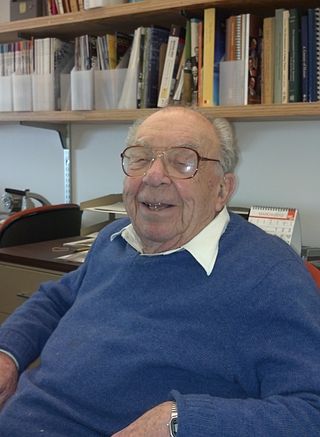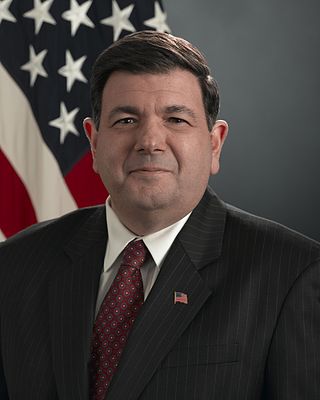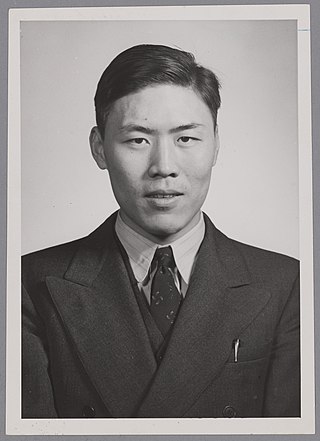
Theodore Harold Maiman was an American engineer and physicist who is widely credited with the invention of the laser. Maiman's laser led to the subsequent development of many other types of lasers. The laser was successfully fired on May 16, 1960. In a July 7, 1960, press conference in Manhattan, Maiman and his employer, Hughes Aircraft Company, announced the laser to the world. Maiman was granted a patent for his invention, and he received many awards and honors for his work. His experiences in developing the first laser and subsequent related events are recounted in his book, The Laser Odyssey, later being republished in 2018 under a new title, The Laser Inventor: Memoirs of Theodore H. Maiman.
Percy LeBaron Spencer was an American physicist, electrical engineer and inventor who became known as the inventor of the microwave oven.

Roberto Mario "Robert" Fano was an Italian-American computer scientist and professor of electrical engineering and computer science at the Massachusetts Institute of Technology. He became a student and working lab partner to Claude Shannon, whom he admired zealously and assisted in the early years of Information Theory.

The MIT Lincoln Laboratory, located in Lexington, Massachusetts, is a United States Department of Defense federally funded research and development center chartered to apply advanced technology to problems of national security. Research and development activities focus on long-term technology development as well as rapid system prototyping and demonstration. Its core competencies are in sensors, integrated sensing, signal processing for information extraction, decision-making support, and communications. These efforts are aligned within ten mission areas. The laboratory also maintains several field sites around the world.
Ivan Alexander Getting was an American physicist and electrical engineer, credited with the development of the Global Positioning System (GPS). He was the co-leader of the research group which developed the SCR-584, an automatic microwave tracking fire-control system, which enabled M9 Gun Director directed anti-aircraft guns to destroy a significant percentage of the German V-1 flying bombs launched against London late in the Second World War.

Jerome Bert Wiesner was a professor of electrical engineering, chosen by President John F. Kennedy as chairman of his Science Advisory Committee (PSAC). Educated at the University of Michigan, Wiesner was associate director of the university's radio broadcasting service and provided electronic and acoustical assistance to the National Music Camp at Interlochen, Michigan. During World War II, he worked on microwave radar development at the MIT Radiation Laboratory. He worked briefly after the war at the Los Alamos National Laboratory, then returned to MIT's Research Laboratory of Electronics from 1946 to 1961. After serving as Kennedy's science advisor, he returned to MIT, becoming its president from 1971 to 1980.

John Roy Whinnery was an American electrical engineer and educator who worked in the fields of microwave theory and laser experimentation.

Robert Morris Page was an American physicist who was a leading figure in the development of radar technology. Later, Page served as the director of research for the U.S. Naval Research Laboratory.
Albert Gordon Hill (1910-1996) was a physicist. He was a key leader in the development of radar in World War II, director of the MIT Lincoln Laboratory development of the electronic Distant Early Warning and SAGE continental air defense systems, and first chairman of The Charles Stark Draper Laboratory. He died in 1996.
Donald Glen Fink was an American electrical engineer, a pioneer in the development of radio navigation systems and television standards, vice president for research of Philco, president of the Institute of Radio Engineers, General Manager of the IEEE, and an editor of many important publications in electrical engineering.

The Radiation Laboratory, commonly called the Rad Lab, was a microwave and radar research laboratory located at the Massachusetts Institute of Technology (MIT) in Cambridge, Massachusetts. It was first created in October 1940 and operated until 31 December 1945 when its functions were dispersed to industry, other departments within MIT, and in 1951, the newly formed MIT Lincoln Laboratory.

Nathan Marcuvitz was an American electrical engineer, physicist, and educator who worked in the fields of microwave and electromagnetic field theory. He was head of the experimental group of the Radiation Laboratory (MIT). He was a member of the National Academy of Engineering. He had a PhD in electrical engineering from Polytechnic Institute of Brooklyn.

Zachary John Lemnios is an American scientist, executive, and engineer who has worked in government, industry, and academia. Most notably, he held the post of Assistant Secretary of Defense for Research and Engineering from 2009 to 2012, and he has served as the first Chief Technology Officer of MIT Lincoln Laboratory, and as Vice President of Research at IBM. Lemnios later founded ZJL Consulting, LLC.

John George Trump was an American electrical engineer, inventor, and physicist. A professor at the Massachusetts Institute of Technology (MIT) from 1936 to 1985, he was a recipient of the National Medal of Science and a member of the National Academy of Engineering. Trump was noted for developing rotational radiation therapy. Together with Robert J. Van de Graaff, he developed one of the first million-volt X-ray generators. He was the uncle of Donald Trump.

Lan Jen Chu was a Chinese-born American electrical engineer and a professor of electrical engineering at the Massachusetts Institute of Technology. Chu is noted for his work on the fundamental limitations for small antennas, also known as Chu–Harrington limit.
George Bekefi was a plasma physicist, a professor at MIT, and an inventor.
Benjamin Lax was a solid-state and plasma physicist.
Charles Herach Papas was an American applied physicist and electrical engineer, known for his contributions to electromagnetic theory, microwaves, radiophysics, gravitational electromagnetics, astrophysics, guided waves, and remote sensing.
Carol Gray Montgomery (1909–1950) was an American physicist. Born in Denver, he earned a bachelor's degree from Caltech and a doctorate from Yale University. At Yale, he helped build an early linear electron accelerator, after which he moved to MIT in 1942, where he undertook war work at the Radiation Laboratory. He wrote or co-authored three volumes of Radiation Laboratory technical publications. He was elected a Fellow of the American Physical Society in 1938, having been nominated by the Bartol Research Foundation where he and his collaborators conducted experimental work with coincidence counters.

David Garratt Hoag was an American aeronautical engineer who was Director of the Apollo Program at the Massachusetts Institute of Technology's Instrumentation Laboratory, later renamed the Charles Stark Draper Laboratory. The Program was responsible for the Apollo Primary Guidance, Navigation, and Control Systems on the Apollo command module and the lunar landing spacecrafts. The Guidance and Navigation system included an inertial measurement unit, optical alignment telescope and space sextant, and Apollo guidance computer, which was used during the Apollo missions.










